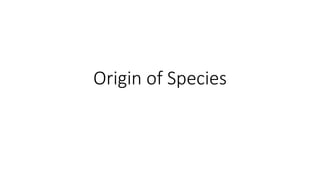
BT1010 Darwin Evolution_Chapter 1 class 3 (2).pptx
- 2. Evolution Charles Robert Darwin (1859)- origin of species by natural selection 1)Species arose from common ancestor (descent with modification) 2)Mechanism is natural selection Population can change over generations if individuals that possess certain heritable traits leave more offspring-results in evolutionary adaptation. Change in genetic composition over time-new species Fossil records can be used to test the evolutionary theory
- 3. Early theories • Aristotle (384-322 B.C)- species is fixed Scala nature (scale of nature)-Each form of life is perfect and permanent and could be arranged on a ladder, or scale of increasing complexity Carolus Linnaeus (1707-1778)- founder of taxonomy: instead of linear hierarchy , he adoped nested classification system (grouping together) (pattern of creation)
- 4. Catastrophism • Most fossils are found in sedimentary rocks (formed from sand and mud that settle to the bottom of water)-new layer covers old one. • Georges Cuvier (1769-1832): 1) deeper the strata more dissimilar the fossils are from current form of life 2) Some species appear and some disappear Catastrophism : confined to local geographic regions
- 5. Gradualism • James Hutton, in 1795: Earth’s Geological change can take place through the cumulative effect of slow but continuous processes. • Charles Lyell- incorporated this into a theory as uniformitarianism. • Darwin reasoned if that is the case, earth must be older than 6000 years and similar process can act on living organism
- 6. Darwin’s voyage-HMS Beagle • Journey began in 1831 with the mission of charting poorly stretches of south American coastline.
- 7. OBSERVATIONS • Various adaptation of plants and animals • Resemblance of species living in particular region: organisms in tropic region of south America resembles temperate region of south America more than the tropic regions of Europe. • Fossils also resemble living organism of that continent. • Geological changes (volcanic eruption in Chile)-Marine organism in Andes mountains Galapagoas Island: Finches were unique to some island, some are distributed to one or more island. Adaptation to environment and origin of new species is related!!!
- 9. • ALLFRED RUSSEL WALLACE (1823-1913)-Developed similar theory and send the paper to Darwin “ORIGIN OF SPECIES”-1859
- 10. • Earnst Mayr dissected Darwin’s theory into 3 inferences and 5 observations: • OBSERVATION #1: All species have such great potential fertility that their population size would increase exponentially if all individuals that are born reproduced successfully. • OBSERVATION #2: Populations tend to remain stable in size, excepting seasonal fluctuations. • OBSERVATION #3: Environmental resources are limited. • INFERENCE #1: Production of more individuals than the environment can support leads to a struggle for existence among individuals of a population, with only a fraction of offspring surviving each generation.
- 11. • OBSERVATION #4: Individuals of a population vary extensively in their characteristics; no two individuals are exactly alike. • OBSERVATION #5: Much of this variation is heritable. • iNFERENCE #2: Survival in the struggle for existence is not random, but depends in part on the hereditary constitution of the individuals. Those individuals whose inherited traits best fit them to their environments are likely to leave more offspring than less fit individuals. • INFERENCE #3: This unequal ability of individuals to survive and reproduce will lead to a gradual change in a population with favorable characteristics accumulating over the generations
- 12. Artificial selection • Artificial selection is the identification by humans of desirable traits in plants and animals, and the steps taken to enhance and perpetuate those traits in future generations
- 13. Can predation pressure selects for size and age of maturity? Dr. Reznik and Endler
- 14. Drug resistant HIV -3TC: Blocks reverse transcriptase -Natural variant that is resistant to 3TC have no advantage, replicate slower
- 15. Important points to note • Individuals don’t evolve, population do. • Natural selection can amplify or diminish only heritable traits. • Trait that is favourable in one situation may be detrimental or useless in another.
- 16. Explanation for other observations • Homology : Similarity resulting from common ancestry Anatomical homologies
- 17. Anatomical homology- Vestigial organs Remnants of structures that serve important function in the organism’s ancestors
- 18. Homology at molecular level
- 19. Biogeography • Closely related species tend to be in a same geographic region (same ecological niches in different region may be occupied by similar looking but very different species) Convergent evolution
- 20. Overview -Darwins Origin of species -Earlier theories preceding origin of species -Examples of Natural selection -How anatomical homology and convergent evolution is explained by Darwin’s view of life